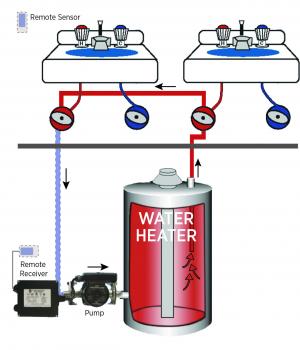Demand Pumping System =

Traditional hot water distribution systems consist of a trunk and branch layout. This consists of a relatively long, large-diameter main line that feeds smaller branches that flow to plumbing fixtures or split to serve multiple fixtures. Even in relatively small homes of 1,200 square feet, the volume to the furthest fixture can exceed 1.5 gallons and the time to the tap can be more than 90 seconds. An effective option for saving water in new homes is to lay out the plumbing in "series" to each fixture and appliance with a dedicated return to the water heater from the most remote location (This is called "structured plumbing"). An in-line pump is installed near the water heater to move the cold water sitting in the pipes back through the water heater before it comes out of the hot water tap, to reduce the amount of water wasted while waiting for hot water. A similar system can be set up for existing homes that locates the pump at the most remote fixture. To save energy, the pump can be set up as an "on-demand" system that is activated by a sensor or switch to avoid the needless calculation of hot water that occurs with inefficient, continuously recirculating pump systems. DOE’s Zero Energy Ready Home program requires that no more than 0.6 gallons of hot water be discharged from a hot water fixture before hot water delivery. Recirculation pump systems must be based on an occupant-controlled switch or an occupancy sensor.